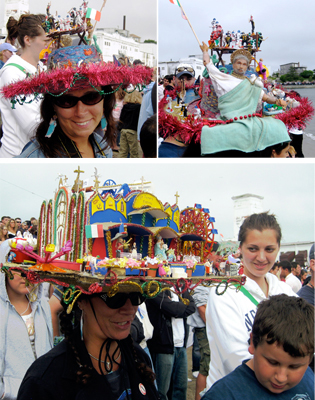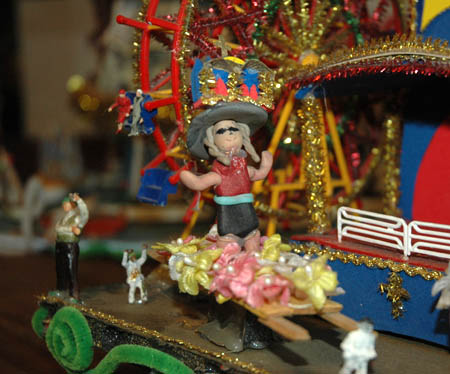It’s late March and we are well into planning the folk craft area of the 2012 Lowell Folk Festival. Though the festival is best known for its music and food, there has long been a vibrant showing of traditional craft by artists who demonstrate their work under tents located along the canal in Lucy Larcom Park. The theme for the area this year is “Head to Toe” and we are in the process of identifying people who craft a variety of head gear (hats, Caribbean carnival headdresses, crowns, head wraps, etc.) and foot wear (handmade shoes of all kinds).
High on my list for awhile has been finding the Hat Ladies of Fiesta. The first I’d heard of them was in the summer of 2009, when I was lucky to have two college interns who spent the summer documenting ethnic festivals around Massachusetts. (Ellen Arnstein and Signe Porteshawver’s fieldwork is sprinkled throughout our Keepers of Tradition website). A highlight for them was attending Gloucesters’ St. Peter’s Fiesta in late June, which honors the patron saint of fishermen. In amongst their photos were shots of two women wearing fantastic hats.

After a little research I discovered their identity: Robyn and Amy Clayton. As it turns out, the Clayton sisters are known around Gloucester as “The Crazy Hat Ladies of Fiesta.” Their outlandish hats have become an integral part of St. Peter’s Fiesta. I wrote them a letter back in December and soon after had an invitation to come meet with them in Gloucester to learn all about their hats.
What started as a backyard party 18 years ago has grown into a highly anticipated display of creativity. It’s just around this time of year that Robyn and Amy begin working on their Fiesta hats. Made from scratch, each hat replicates in miniature key elements of Fiesta: local churches, temporary altars, the St. Peter statue, the greasy pole competition, Gloucester’s fishing fleet, concession stands, and carnival rides.

A couple of weeks ago, I found myself sitting at the kitchen table in Robyn Clayton’s home. Spread out on nearly every available surface were hats from previous years and supplies for creating this year’s hats including large light slabs of foam core, pipe cleaners, glue, popsicle sticks, paint, Sculpey clay, Legos, and HO-scale model railroad figures.

Robyn modeled last year’s hat for me. “My friends joke that when I put this hat on, I’m going to need some kind of out riggers because they think it’s so heavy, but it really isn’t heavy. It’s just a little awkward if it’s really windy out.” Not to be missed is Robyn’s replica of herself on her hat, wearing her signature hat, standing in front of the working Ferris wheel.

Though they create new hats with a new theme each year, some things stay the same. Amy’s hats always include the greasy pole and Robyn’s always feature the altar. All the references are local. Robyn points out a perennial figure, “This guy here is always on my hat. He’s Ambie, the sausage man. He’s also my UPS man. It looks just like him. Made him out of some Legos, some Sculpey clay, and the left over umbrella from a Mai-Ti.”

Robyn describes the early days of Fiesta, “Way back when, when there was a huge fishing fleet, this was a huge celebration. The carnival wasn’t involved. This was about people dressing their houses. They would put their old quilts out the window. Fiesta has been going on for a long time. Same thing for the greasy pole competition. What they did was, they just paraded St. Peter up and down. It was about the feast. It was about praying for people’s families and the safety of their men. . . St. Peter has been put around different areas. He used to sit in the old grocery store windows. As the fishermen would go out to their boats, as they went by St. Peter, they would pray to him. Just keep us safe. Bring us back home.”
The original life-size statue of St. Peter, which was brought over from Italy in 1927, remains the centerpiece of what has become a five-day celebration. Recently, Robyn was inspired to make her own statue of St. Peter. During the year, the statue of St. Peter is kept at the Saint Peter’s Club on Rogers Street; Robyn’s Saint Peter hibernates in her cellar.


I wonder aloud what the older, Italian generation of Fiesta think of this relatively new addition to their festival. “The old Italian women absolutely love these hats,” Robyn says. “The Fiesta committee [which is made up of mostly men], they recognize us as the crazy fiesta hat girls. Here we come. By no means are we mocking the Fiesta; we love this tradition.”
The Clayton sisters are elated to be coming to the Lowell Folk Festival this July, where they will join a variety of other hat and shoe makers in the folk craft area. They plan on bringing plenty of hats, some handouts, pictures of Fiesta over the years, and a huge cut-out of St. Peter for photo-taking opportunities. Their enthusiasm for hat making will be matched by their pride in representing Gloucester and St. Peter’s Fiesta. We’re honored to have them.

ciao gina. questa storia e senplicemente fantastica.- non o molte parole la storia si commenta da sola. una storia bella, illustrata con delle coloratissime e fantasiose foto. con dei cappelli bizzarri che rientrano perfettamente nella tradizione in modo folcloristico. purtroppo la traduzione toglie leggermente la profondita del testo . colgo l’occasione per salutarti e spero tutto beme cugina carissima<3
Maggie!
This is fantastic! How exciting! Miss working with you so much, what an awesome treasure hunt concluded.
Ellen
This is simply amazing. Excellent post of this ladies hat fiesta, specially the first image is so innovative and unique work. Fantastic job.